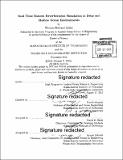Real time bottom reverberation simulation in deep and shallow ocean environments
Author(s)
Miller, Thomas Edward, S.M. Massachusetts Institute of Technology
DownloadFull printable version (9.730Mb)
Other Contributors
Woods Hole Oceanographic Institution.
Advisor
Henrik Schmidt.
Terms of use
Metadata
Show full item recordAbstract
Due to the costs involved and time required to perform experiments at sea, it is important to provide accurate simulations of the ocean environment. Using the ray tracing code, BELLHOP, the Mission Oriented Operating Suite (MOOS), methods outlined by the Naval Research Laboratory (NRL) for bottom reverberation, and MATLAB, a model will be developed to incorporate the effects of bottom reverberation into the BELLHOP suite of code. This will be accomplished by using BELLHOP to generate a ray trace and eigen ray file. Then a MATLAB script will take the BELLHOP information and calculate the reverberation level using the NRL model by measuring the amplitude and reverberation at a receiver array simulated on the ocean floor. These reverberation values will then be used to determine the reverberation level at the source due to these bottom interactions. Testing of the simulation will include deep and shallow ocean profiles and multiple sound speed profiles (SSP). Following this testing, the goal is to implement the model in existing C++ code used for the testing of AUV systems. The ability to accurately model the ocean will not only allow for testing of autonomy code in the laboratory, but also make it possible to refine and calibrate code making ship time more efficient.
Description
Thesis: S.M., Joint Program in Applied Ocean Science and Engineering (Massachusetts Institute of Technology, Department of Mechanical Engineering; and the Woods Hole Oceanographic Institution), 2015. Cataloged from PDF version of thesis. Includes bibliographical references (page 77).
Date issued
2015Department
Joint Program in Applied Ocean Physics and Engineering; Woods Hole Oceanographic Institution; Massachusetts Institute of Technology. Department of Mechanical EngineeringPublisher
Massachusetts Institute of Technology
Keywords
Joint Program in Applied Ocean Science and Engineering., Mechanical Engineering., Woods Hole Oceanographic Institution.